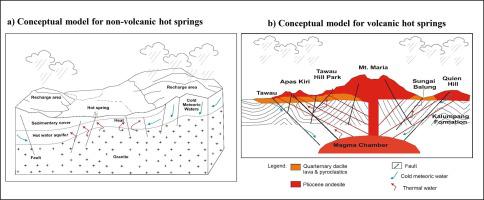Journal of Asian Earth Sciences ( IF 2.7 ) Pub Date : 2021-05-29 , DOI: 10.1016/j.jseaes.2021.104843 Mohammad Noor Akmal Anuar , Mohd Hariri Arifin , Hassan Baioumy , Mohd Nawawi

|
Sources of volcanic and non-volcanic thermal sources have been studied in East Malaysia to differentiate their geothermal reservoir temperatures and first-ever reports on its geochemical processes that affect the evolution of the constituents of thermal groundwater subsurface circulation. The study of geothermal potentials includes indices of geochemistry, geothermometry, and mineral saturation. The surface temperatures of thermal springs range from 27 to 56 °C, and the pH values range from 5.6 to 9.0. The geochemical characteristic distinguishes non-volcanic thermal sources as K-Na-HCO3, while volcanic thermal sources present the Cl-HCO3-SO4-Na type. The quartz geothermometer showed that the reservoir temperatures of non-volcanic hot springs range between 61 and 135 °C. In comparison, the volcanic thermal sources range from 55 to 185 °C requiring 257 to 565 kJ/kg and energy from 231 to 786 respectively to heat water. Subsequently, it is defined as intermediate to slightly high enthalpy for most thermal springs, especially volcanic springs. The mixing of hot water with sources close to the surface can be seen by the disagreement between the silica and cation geothermometers and the disequilibrium with their associated host rocks as indicated from the plot of studied hot springs in the Na-K-Mg ternary diagram and saturation indices calculations. Radiogenic granitic host rock represents the main heat source for non-volcanic hot springs govern by meteoric water generated in deep-seated fault systems. Meanwhile, in volcanic areas with high secondary permeability caused by faults, fractures and fractures, meteorological waters can descend to a considerable depth and heat up. In a favourable situation, thermal waters return to the surface by faults and fracture zones.
中文翻译:

东马火山和非火山温泉的地球化学比较:对它们的起源和地温测量的影响
已在东马来西亚研究了火山和非火山热源的来源,以区分它们的地热储层温度,并首次报道了影响地下水地下循环成分演变的地球化学过程。地热潜力研究包括地球化学、地温测量和矿物饱和度指数。温泉表面温度范围为 27 至 56 °C,pH 值范围为 5.6 至 9.0。地球化学特征区分非火山热源为K-Na-HCO 3,火山热源为Cl-HCO 3 -SO 4-Na 型。石英地温计显示非火山温泉的储层温度在61-135°C之间。相比之下,火山热源的温度范围为 55 至 185 °C,分别需要 257 至 565 kJ/kg 和 231 至 786 的能量来加热水。随后,对于大多数温泉,尤其是火山温泉,它被定义为中等至稍高的热焓。从 Na-K-Mg 三元图中研究的温泉图可以看出,二氧化硅和阳离子地温计之间的不一致以及与其相关的主岩的不平衡可以看出热水与靠近地表的源的混合。饱和度指数计算。放射成因花岗岩主岩是非火山温泉的主要热源,由深部断层系统产生的大气水控制。同时,在断层、裂隙、裂缝等形成的次生渗透率较高的火山区,气象水可以下降到相当大的深度并升温。在有利的情况下,热水通过断层和断裂带返回地表。











































 京公网安备 11010802027423号
京公网安备 11010802027423号